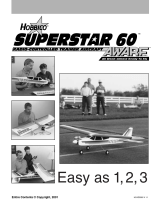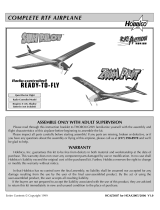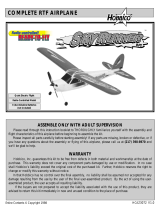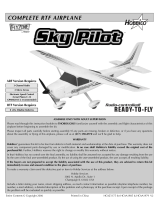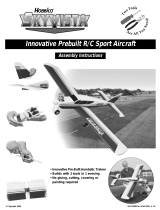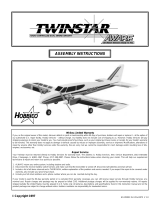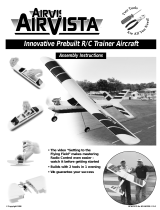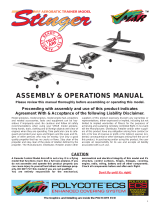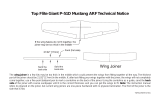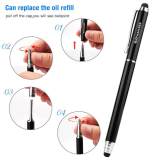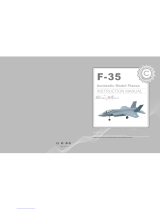Page is loading ...

Entire Contents © Copyright, 1995
HCAZ3005 V 1.0

KNOW YOUR MODEL'S PARTS.
Take a moment now to
match the box contents
with the items listed here.
Following the Avistar
assembly instructions
will be quite easy if you
identify and organize the
parts before you begin.
Engine Mounting Parts
Part# Quantity
3mm nuts ............................................4
3 x 25mm machine screw...................4
3mm washers ......................................4
Push rods.............................................. 2
3mm lock washers..............................4
Pushrod guide tubes...........................2
46
25
26
28
43
.53
Wing Assembly
Part#
Quantity
included at the back
this manual.
Right wing with aileron.............................1
Left wing with aileron ............................... 1
Plywood wing joiners................................3
Wing center tape .......................................1
Aileron servo tray......................................1
Aileron servo tray mounting blocks.........2
Aileron control horns................................2
Threaded aileron pushrods......................2
Clevises ......................................................2
Clear clevis retaining tube........................1
Wing alignment package.......................... 1
35
Please take your time and read through the instruction
manual before starting to build your new airplane. If
you have any questions, please feel free to give us a call
at (217) 398-8970. We hope you enjoy building and
flying the Avistar.
Replacement Parts Available
HCAA3020 Wing Kit
HCAA3021 Fuselage Kit
HCAA3024 Wing Tip Set
HCAA3022 Tail Set
HCAA3023 Land ing Gear Set
25
28
23
19
21
2
-hank you for purchasing the Hobbico Avistar ARF! This all
wood sport/trainer can be ready to fly in a fraction of the time
it would take to build a conventional wood kit. It features a
semi-symmetrical airfoil for a good combination of acrobatic
performance and stability. With the help of a competent
instructor, learning to fly the Avistar is easy and enjoyable. For
the sport pilot, the acrobatic capabilities are far superior to
basic trainers with flat-bottom wings.
Horizontal stab and elevator......... I
Vertical fin and rudder...................1
Clevises...........................................2
Control horns .................................2
Clear retaining tube....................... 1
Pushrods.........................................2
2 x 15mm machine screws ............4
Dorsal Fin .......................................1
Dorsal Fin Decal.............................1
Tail Assembly
Part#
Quantity

3
0
10
20
30
40
50
60
70
80
90
100
110
120
130
140
150
Metric Scale
Inch Scale
0"
1"
2"
3"
4"
5"
6"
Fuselage.................................
1
Wing mounting dowels.........2
Servo tray...............................1
Plywood stab base.................1
Spinner...................................1
Servo tray support.................1
Part#
Quantity
17
18
14
13
15
16
33
Fuel Tank & Parts
Part#
Fuel tank.............................................. 1
Rubber tank stopper...........................1
Fuel pick-up weight (clunk) ...............1
Plastic stopper disks
(one
large
and one
small)
...................2
Aluminum fuel tubing
(one short and two long) ....................3
3 x 18mm sheet metal screw ..............1
Silicone
Fuel
line..................................1
Foam tank collar .................................1
Quantity
* Sketches shown are not
actual size or to scale.
47
29
27
32
Landing Gear
Part#
Quantity
Main landing gear struts ...........2
Nose
gear
strut
...........................1
Plastic Steering Arm................... 1
Landing gear straps ...................2
Wheels........................................2
Wheel collars w/ set screws ......4
3 x 10mm sheet metal screws ...4
Pushrod connector
....................2

Glues
Choose a high quality 6-minutc and 30-minute epoxy, such
as Great Planes Pro Epoxy, which has been formulated
especially for R/C model building. Pro Epoxies offer a strong
bond and a variety of curing times suited for every step of
assembly. You'll also need a thin, instant-setting CA
(cyanoacrylate), a thicker CA+, plus rubbing alcohol for easy
epoxy cleanup.
Hardware
Tools and accessories required for assembly
include a hobby knife, small and large Phillips
screwdrivers,
needle
nose
pliers,
drill
with
1/16", 1/8", 11/64", 5/64", 3/32" and 5/32" bits,
ruler, #64 rubber bands, 1 foot of medium fuel
tubing, and petroleum jelly.
Model Engine
Power your Avistar with any high-quality,
.40-size model engine. The O.S. .40 FP or
Super
Tigre
GS-40
are
fine
engines
for
this
plane.
Look for features such as easy break-in, easy
starting, efficient carburetion and low
maintenance. Check the manufacturer's
recommendations for propellers to use with
your engine.
Radio Equipment
To control your Avistar's "flight path," you'll need a 1991
legal 4-channel aircraft radio system with tour standard
servos. Many 4-channel radios include just three. You may
need to purchase the fourth separately, Hobbico Command
servos
are
available
singularly
and
will
work great for this
plane. '1 he servos, battery pack, and radio receiver will he
mounted on-board vour model and need to be cushioned
from
jolts
and
vibration.
I
Half-inch
thick
foam rubber
sheets
(BCAQ1050) are available for this purpose.
Getting Ready for Flight
Your Hobbico Avistar can be ready for takeoff in as little as 20 hours. Your
hobbv dealer or flying instructor (see next page) can help you decide what
accessories you'll need for flight. Most are one-time-only purchases - like a
glow plug igniter (see glossary), fuel pump, and "chicken stick" or electric
starter.
You
will
also
need
to obtain model glow
fuel.
Use glow fuel with
a
10-
15% nitro content to keep your engine performing at its peak.
Other General Items Required
Epoxy Brushes (GPMR8062)
Foam Kubber (HCAQ1050)
Felt lip Pen
Masking Tape
Z-Bend pliers
(Optional)
Wire Cutter
Mixing Sticks (GPMR8055)
Phillips Screwdriver
Sanding Block w/ 150 grit paper
Medium Fuel Tubing (GPMQ4131)
Rubbing Alcohol
Clothespins
String
Adjustable Wrench
Paper I towels
" 1" Pins
4

I
f you're a beginner, the best way
to begin flying your Avistar is with
an experienced R/C pilot or flying
instructor at your side. You'll learn
faster, and avoid risking your
model before you're truly ready
to solo.
Where do you find an instructor?
Ask at your local hobby shop.
They'll have information about
flying clubs in your area whose
membership includes qualified
instructors. You should also join
the Academy of Model Aeronautics
(AMA), a 165,000 member-strong
national organization with
more than 2,300 chartered
clubs across the country.
Through any one of them,
instructor training programs
are available. Contact the AMA
at the address or phone
number below:
Academy of Model Aeronautics
5151 East Memorial Drive
Muncie, IN 47302-9252
(800) 435-9262
JOIN THE AMA
Before you fly:
1. Make sure that no other fliers are using your
radio frequency.
2. Your radio transmitter must be the FIRST thing you
turn ON, and the LAST thing you turn OFF.
3. Double check all control surfaces, making sure they
are secure and move in the proper direction.
4. Make sure that the transmitter & receiver batteries are
fully charged.
Fuel storage and care:
1. Do not smoke near your engine
or fuel.
2. Store all engine fuel in a safe, cool, dry place, away
from children and pets. Model fuel will evaporate,
so make sure that you always store it with the
cap secure.
When starting and running your engine:
1. Always wear safety glasses.
2. Make certain that your glow plug clip is securely
attached to the glow plug and cannot pop off,
possibly falling into the spinning propeller.
3. Use a "chicken stick" or electric starter to start the
engine - NOT your fingers.
4. Make sure that the wires from your starter and
glow plug clip cannot become tangled with the
spinning propeller.
5. Do not stand at the side of the propeller when you
start or run the engine. Even at idle speed, the
spinning propeller will be nearly invisible.
6. If any engine adjustments are necessary, approach
the engine only from behind the spinning propeller.
90-Day Limited Warranty
II you .1as the original owner of this model, discover a defect in parts
or workmanship within 90 days of purchase. Hobbicowill repair or replace
it
-
.11
the
option
of
our
authorised
U.S.
repair
facility,
Hobby
Services without charge. Our liability does not include cost of shipping to
us.
I
however,
Hobby
Services
will
pay
shipping
expenses
to
return
your
model to you.
You must provide proof of purchase, such as your original purchase
invoice or receipt, tor your model's warranty to he honored.
TI his warranty does not apply to damage or defects caused by misuse or
improper assembly, service or shipment. Modifications, alterations or
repair by anyone other than I Hobby Services voids this warranty. We are
sorry, but we cannot he responsible for crash damage and/or resulting
loss of kits. engines, a cessories. etc.
Repair Service
Your Avistar must he returned directly to 1 Hobby Services for warranty
work. 1 he address is:
Hobby Services. Ann: Service Depart ment, 16) Interstate Drive,
Champaign. 11. (61821-1067 Phone: (217) 398-0007. or for product
information and technical support please contact us at (217) 398-8970
Please follow the instructions below when returning your model. I his
will
help
our
experienced
technicians
to
repair
and
return
it
as
quickly
as possible.
1.
ALWAYS
return
your
entire
system,
including
airplane
and
radio.
2. Disconnect the receiver battery switch harness and make sure that the
transmitter is turned off. Disconnect all batteriesand drain all fuel.
3. Include a list of all items relumed and a THROUGH written
explanation of the problem and service needed. II you expect the
repair to be covered under warranty, also include your proof
of purchase.
4. Include your full return address and a phone number where you can
be reached during the day.
If
your
model
is
[past
the
90-day
warranty
period
or
is
excluded
from
warranty coverage, yon can still receive repair service Ihrough Hobby
Services at a nominal cost. Repair charges and postage may be prepaid or
billed COD. Additional postage charges will be applied lor non-warranty
returns. All repairs shipped outside the United Stales must be prepaid in
U.S. funds only.
All pictures, descriptions and specifications found in this instruction
manual and on the product package are subject to change without notice.
5

Special Note:
You should charge your radio system before starting
to build. Following the manufacturer's directions,
connect your transmitter and receiver batteries to the
system's charger. This way the radio will be ready
when it is time to install and test the components.
both sides of one of the wing joiners. Sandwich this
coated joiner between the remaining two. Quickly
proceed through the following steps (3 and 4) before
the glue cures.
1. Locate the 1/8" (3mm) die-cut plywood wing
joiners. Arrange the three "V-shaped joiners in the
same orientation as they will be glued together. Sand
off any bumps from the edges.
Remove the excess epoxy
LJ 3. Excess epoxy will squeeze out of the seams
between the joiners and must be removed before the
epoxy is allowed to cure. Use a paper towel to remove
the excess epoxy.
Glue the wing joiners
Note: Please read steps 2 through 4 before gluing.
Q 2. Mix approximately 1/4 oz. (7.5ml) of 30-minute
epoxy using a mixing stick and a cup. Using a mixing
stick or epoxy brush, apply an even coat of epoxy on
Clamp the wing joiner
Q 4. Use clothespins to clamp the wing joiners firmly
together. If any more epoxy squeezes out, remove
using a paper towel. Make sure the joiners are evenly
lined up with each other, set this aside until
fully cured.
6

Mark the centerline on the joiner Trial fit the wing joiner
5. After the epoxy has cured and the clothespins
have been removed, draw a centerline on both
sides of the plywood wing joiners and the two balsa
5/16" square x 1-7/16" (8mm square x 36mm) aileron
servo tray mounting blocks. Use the plywood joiner
as a template to mark the wing dihedral angle on both
of the balsa aileron servo tray mounting blocks. Put
the balsa blocks aside for use in later steps.
Even the edges
1-1 6. Using a flat sanding block or similar tool, sand
the wing roots so they will seat together with no gaps.
Do not sand too much or the dihedral angle
could change.
Mark the wing cavity
Q 7. Mark the aileron servo location on both wing
panels using a felt tip pen. Using a hobby knife, cut an
opening into the panels following the lines you
just drew.
Q 8. Trial Fit the wing joiner in both wing panels by
sliding the joiner into the joiner cavity in the wing.
The joiner should slide in with little resistance up to
the centerline. Also trial fit the 3.6mm x 4mm x 25mm
wing alignment peg into the holes at the trailing edge.
If the wing joiner will not fit in the cavity, lightly sand
any excess epoxy or uneven surfaces from the joiner
edges, sides and ends. Caution: A snug fit is desirable
between the joiner and the wing cavity. Do not
sand excessively.
Viewing the wing dihedral
Q 9. Pay close attention to the orientation of the wing
joiner in relation to the wing panel, creating the
dihedral angle as shown. Trial fit the wing panels
together. They should Fit flush against each other with
no gaps.
NOTE: When performing the following steps, be sure
to use a sufficient amount of epoxy to form a
complete and solid bond between the plywood wing
joiner and the two wing halves. This is the most
important glue joint the entire airplane.
7

Please read through the following three steps before
mixing any epoxy. You must complete these steps
within 20 minutes from the time you mix the epoxy.
Glue the joiner
outside of the wing using a paper towel dampened
with rubbing alcohol. Use several strips of masking
tape on both sides to hold the wing halves tightly
together. Let the epoxy fully cure.
Q 10. Mix l/2oz. (15ml) of 30-minute epoxy. Use a
mixing stick or epoxy brush to apply epoxy to all four
sides of the joiner cavity wall. Insert the joiner into the
cavity up to the centerline marked on the joiner plate.
Be sure you are installing the joiner correctly. Quickly
proceed to the next step.
Apply epoxy to the wing root rib
Q 11. Apply epoxy inside the joiner cavity of the
remaining wing panel. Next, coat the wing root ribs
on both panels. Insert the wing alignment peg into
the hole at the trailing edge. Quickly proceed to the
next step.
Join the wing halves
-I 12. Assemble the two wing halves with the tightest
seam possible. No gaps should be showing between
the two wing halves. Clean any excess epoxy from the
Trim the covering
Q 13. Hold the plywood aileron servo tray over the
hole in the bottom of the wing. Trace the outside of
the tray with a felt tip pen and then remove the tray
from the wing. Draw two lines 5/16" from the ends
as shown. Carefully remove only the covering within
the lines using a new #11 blade in a hobby knife,
being careful not to cut into the balsa
wing sheeting.
Shape the mounting blocks
Q 14. Locate the two balsa servo tray mounting
blocks (marked earlier in step #5 page 7) and position
them with the marked dihedral line up. Cut or sand
the marked angle out of the block. This angled side
will be placed against the wing when the servo tray
is installed.
8

Assemble the servo tray
15. Glue the balsa aileron servo blocks onto the
servo tray so that the angled side you just cut is facing
away from the plywood tray.
Trial fitting the aileron servo
Q 16. Trial fit the aileron servo into the servo tray and
the hole in the bottom of the wing. Enlarge either
hole, if needed, with a hobby knife or a fine-toothed
file until a proper fit is achieved.The plywood tray
should not actually contact the servo. Leave a 1/64"
gap all the way around. Remove the servo.
Install the servo tray
—J 17. Mix l/8oz. (3.5ml) of 6-minute epoxy to glue
the servo tray to the bottom side of the wing. Apply
equal amounts of epoxy to the mounting blocks on
both ends of the servo tray. Attach the servo tray to
the bottom of the wing with the servo wire harness
notch facing the leading edge of the wing. Allow the
epoxy to fully cure before proceeding to the next step.
Apply the center tape
Q 18. Starting at the front of the aileron servo tray,
apply the 1/2" (12.5mm) white wing center tape
completely around the wing over the joint. A small
amount of pressure should be applied to make a
smooth seam.
Check the aileron hinge
D 19. Gently tug on each of the ailerons at each hinge
location. If any of the hinges are loose, reglue them as
described here. First, flex the surface all the way one
direction (DO NOT REMOVE THE AILERON). Apply 5
drops of thin CA onto each hinge. Use a paper towel
to absorb any excess glue. Wait a few minutes for the
glue to harden, then flex the surface the other
direction and glue the other side of the hinges
in the same manner. Finally, flex back
and forth several times to free up
the aileron.
9

Install the aileron control horns Securing the aileron pushrods
_1 20. Thread (he aileron control horns onto the
torque rods until there is 3/4" (19mm) of torque rod
between the wing and control horns.
1-1 23. Locate the 1/4" (6.5mm) diameter clear
retaining tube and cut two 1/4" (6.5mm) pieces. Slide
one piece onto each clevis to secure the connection
between the clevis and the horn.
Assemble the pushrods
This concludes the wing assembly for now. Tape the
pushrods to the wing to keep them in place until you
install the servo.
Q 21. Locate two plastic clevises and two 8" (203mm)
aileron pushrods. Thread the clevises onto the
threaded end of the pushrods until the rod begins to
protrude inside of the clevis between the forks.
Install the pushrods
Q 22. Attach the pushrods to the aileron control
horns. Press the forks of the clevis together until they
snap into place.
10

Locate the wing dowel holes
1. Locate the four round holes, two on each side of
the fuselage, and remove the covering over each hole.
Caution: Do not cut out the rectangular holes in the
side of the fuselage.
Locate the stabilizer slot
Q 3. Locate the horizontal stabilizer slot under the
covering on the tail section of the fuselage by pressing
lightly with your finger. The slot is located on both
sides of the tail. Using a hobby knife, carefully remove
the covering, exposing the slots. NOTE: Do not cut
into the wood around the slot.
Install the plywood stabilizer mount
Install the wing dowels
D 2. Insert both wing mounting dowels so they
protrude an equal amount on both sides. Mix 1/4oz.
of 30-minute epoxy. Apply glue around the dowels
next to the fuselage and rotate them in and out to help
force the glue into the holes. Using a paper towel,
spread the excess glue around the ends of the dowels.
This will fuelproof and add strength to the wood.
From the inside of the fuselage, apply more epoxy
around the dowels where they meet the sides. These
wing dowels
will
be used as anchors
for
rubber
bands
to hold the wing in place.
LJ 4. Locate the 1/8" (3mm) plywood stabilizer
mounting base and trial fit it into the bottom of the
horizontal stabilizer slot. Lightly sand the base if
necessary to obtain a good fit. Remove the base from
the fuselage.
Glue the mount in place
Q 5. Mix 1/8oz. (3.5ml) of 30-minute epoxy. Using a
mixing stick, apply a generous amount of glue into the
slot and position the stabilizer mounting base firmly
in position. Remove any excess epoxy that remains on
the top of the stabilizer base and on the outside of
the fuselage.
11

Remove the tail post
them as described here: First, flex the surface all the
way one direction (DO NOT REMOVE THE SURFACE).
Apply 5 drops of thin CA onto each hinge. Use a paper
towel to absorb the excess glue. Wait a few minutes for
the glue to harden, then flex the surface the other
direction and glue the other side
of the hinges. Finally, flex the
surface back and forth several
times to free it up.
6. Located at the rear of the fuselage, behind the
horizontal stabilizer slot, are the balsa tail posts. These
posts were left for manufacturing alignment. The
posts must be removed in order to insert the
horizontal stabilizer. Using a sharp hobby knife or
razor saw, cut the posts even with the slot as shown in
the picture.
Locate the vertical fin slot
CJ 7. Using your finger, locate the vertical fin slot on
the top of the fuselage. Remove the covering with a
hobby knife.
Check the rudder and elevator hinges
Q 8. Gently tug on the rudder and elevator at each
hinge location. If any of the hinges are loose, reglue
Mark the centerline
-J 9. On the top surface of the horizontal stabilizer,
measure to find the exact center from side to side.
Draw a "center line" using a felt-tip pen. Next, extend
that line onto the trailing edge, in the hinge gap, as
shown. (DO NOT MARK ON THE ELEVATOR.)
Align the stabilizer with the wing
A=A
B=B
A
A
B
B
Q 10. Insert the stabilizer into the horizontal
stabilizer slot so it is centered in the fuselage (A). Place
the wing onto the fuselage and view the plane from
the rear. The stabilizer should be parallel with the
wing (B). If not, sand the stabilizer mounting plate a
little at a time until correct.
12

Align the stabilizer with the fuse
T-PIN
STRING
STRING
EQUAL MEASUREMENTS
drawn in the last step. Next, carefully cut through the
covering using a new #11 knife blade at the inside
lines and remove the covering from the center. Do not
cut the wood under the covering! This would
seriously weaken the stabilizer and could easily
cause the stabilizer to break in flight. If the stab
breaks the plane may crash, so be very careful when
you make this cut.
11. Attach a piece of string with a T-pin to the
center of the fuselage as shown. Hold the string to the
corner of the horizontal stabilizer. The distance from
the pin to the horizontal stabilizer must be exactly the
same on both sides.
Mark the stabilizer location
Q 12. With the stabilizer properly aligned, using a felt
tip pen, trace a line around the tail of the airplane on
the top and bottom of the horizontal stabilizer.
Remove the center covering
LJ 13. Remove the stabilizer and draw two additional
lines, on the top and bottom, 1/16" inside the lines
Install the stabilizer
—1 14. Mix 1/4oz. (7.5ml) of 30-minute epoxy. Using a
mixing stick, place glue inside the horizontal stabilizer
slot on all sides including the horizontal stabilizer
mount. Insert the stabilizer from the rear, and adjust
the alignment. Wipe off any epoxy that squeezes out
using a paper towel dampened with rubbing alcohol.
Re-check the alignment. Then, take a break until the
glue cures.
Install the vertical fin
U 15. Trial fit the fin into the slot in the top of the
fuselage. Sand the edges if necessary for a snug fit.
Mix 1/4oz. (7.5ml) of 30-minute epoxy. Using a
mixing stick, apply epoxy to the top of the horizontal
stabilizer through the slot. Apply epoxy to the sides
and bottom surfaces of the fin base that have balsa
wood exposed. Insert the Fin into the slot, making sure
the fin base is seated firmly on the horizontal
stabilizer. Check for a perpendicular angle between
the fin
and
the
stabilizer when
viewing from the
rear. Check this
alignment several
times as the
epoxy cures.
90
90°
13

Apply the decaf to the dorsal fin Attaching the rudder control horn
Q 16. Attach the white decal to the balsa dorsal fin by
wrapping it around the top. Trim off the excess decal
material even with the edges. Do not apply to the flat
bottom or aft edges
Install the dorsal fin
Q 17. Hold the dorsal fin in position in front of the
vertical fin. Use a ruler to measure and position the
front tip of the fin in the center of the fuselage.
Using a small amount of6-minute epoxy, carefully
glue the dorsal tin onto the fuselage and to the vertical
fin, making sure it is centered properly.
Locations of the control horns
Q 18. Notice the locations and alignment of the
control horns in this photo marking and drilling. The
rudder control horn must be on the left side. The
elevator horn must he underneath
and on the right side. The control
horns should be positioned so
the holes are lined up with the
hinge line. (See sketch)
1-1 19. Position a control horn as shown in the
previous sketch, 7/8" (22 mm) from the bottom of the
rudder. Mark the two holes with a felt tip pen. Angle
the horn slightly so it is straight with the fuselage.
Attach the control horn
Q 20. Drill two 3/32" (2.4 mm) holes straight through
the balsa rudder at the marks. Place a drop of thin CA
into each hole. This will add strength to the balsa.
Redrill the holes to remove any excess glue. Insert two
2 x 20mm machine screws through the control horn,
and rudder, then finally screwing them into the
control horn back plate on the opposite side of the
rudder. Tighten the screws but do not crush the balsa.
Cut off the excess threads that stick out using a
wire cutter.
Install the elevator horn
Q 21. Attach the elevator control horn in the same
manner as the rudder. Place the control horn on the
bottom of the elevator 7/8" (22mm) away from the
fuselage (see previous photo at step 18). Mark the two
holes with a felt tip pen. Drill two 3/32" (1.6mm) holes
straight through the balsa elevator at the marks. Place
a drop of thin CA into each hole. Redrill the holes to
remove any excess glue. Thread two 2 x 20mm
machine screws through the control horn, elevator
and finally into the control horn back plate on the
opposite side. Tighten the screws but do not crush the
balsa. Cut off the excess threads.
Hinge Line
14

Cut the rudder pushrod exit Prepare the channel for the gear
22. The pre-cut rudder pushrod exit hole is located
on top of the fuselage on the same side as the rudder
control horn. Using a hobby knife, remove the
covering from the rudder pushrod exit hole.
Cut the elevator exit
D 23. The pre-cut elevator pushrod exit hole is located
on the same side of the fuselage as the elevator control
horn. Locate the exit hole by gently running your finger
along the side of the fuselage over the covering. It
should be located approximately 1/2" in front of the
stabilizer where shown. Using a hobby knife, remove
the covering from the elevator pushrod exit hole.
Locate the landing gear channel
Q 24. On the bottom of the fuselage, there is a
channel for the main landing gear. Locate this
channel by running your finger over the covering on
the bottom of the fuselage. Using a hobby knife,
remove the covering from this channel.
J 25. Trial fit the chrome wire landing gear struts
into the holes. It they will not go in easily, drill out the
two holes using an 11/64" drill bit. Next, use the drill
bit or hobby knife to bevel the inside corners of the
holes so that the bend in the wire will seat fully into
the holes.
Install the landing gear struts
Q 26. Position the two wire struts in the holes inside
the channel. Center the two landing gear straps over
the struts so they are approximately 1/2" from the
sides of the fuselage. Mark the holes using a felt tip
pen.
Drill the fuselage
Q 27. Drill four holes using a 1/16" (1.6 mm) drill bit.
Mount the struts
Q 28. Using four 2.5 x 10mm self-tapping screws,
fasten the landing gear straps to the bottom of the
fuselage over the struts.
15

Engine Selection
The following steps 29 through 36 show the
installation of components if a 2-stroke engine is
used. If you are planning to install a 4-stroke engine,
you will need to install the throttle and steering
pushrods on the opposite side than what is shown in
the photos. Pay extra attention to any special notes
covering 4-stroke installation in the text.
Install the throttle guide tube
1-1 29. Cut a small notch that is 1/8" wide and 1/8"
deep into the front fuselage former approximately
3/4" down from the top of the fuel tank opening. This
will give the throttle pushrod a straighter line to the
servo. Cut the two white plastic pushrod guide tubes
so they are both 11" long.
Drill the steering pushrod exit hole
1 31. Measure and mark the steering pushrod exit
onto the bottom of the fuselage 1-3/4" back from the
fuselage and 3/4" in from the left side as shown. Using
a 1/8" drill bit, drill a hole that angles in towards the
back of the fuselage as shown. Be careful not to let the
drill chuck damage the covering.
Install the steering guide tube
—1 32. Slide the remaining guide tube into the hole
you just drilled so that 2-112" protrudes. Mix 1 /8oz. of
6-minute epoxy. Glue the tube into the hole and into
the lower left slot inside the fuselage. Once the epoxy
has
cured, trim
off
this tube so
it
is
flush with the
bottom of the fuselage (see photo at step 36).
Make "Z" bends inthewire
Q 30. Using sandpaper, roughen the outside of both
plastic guide tubes and clean with a paper towel
dampened with rubbing alcohol. This will help the
glue stick to the tubes. Install one of the tubes into the
upper hole in the firewall. Position the tube so that
approximately 2" protrudes out of the firewall. Mix
1/8oz. of6-minute epoxy and glue the guide tube into
the hole in the firewall and into the notch inside the
fuselage as shown. Note: If you are installing a
4-stroke, you will need a new 1 /8" hole for the throttle
pushrod. Drill this hole so it lines up behind
the carburetor arm on your engine. The predrilled
hole is not needed and should be plugged with
6-minute epoxy.
D 33. Make a Z-bend at one end of both of the
1/16" x 18" wire pushrods using needle nose pliers.
NOTE: Hobbico offers pliers that easily make perfect
Z-bends (HCAR2000). See your hobby dealer.
Trim the steering arm
Q
34.
Locate
the black plastic steering arm.
I
hold
the
arm in your hand so that the screw hole is facing you.
Using a wire cutter, remove the left side of the arm
(right side if installing a four stroke). It is not needed.
16

Install the steering pushrod Assemble the fuel tank plug
_J 35. Attach the "Z" bend of One of the wires into the
outside hole of the black plastic steering arm. Slide
the wire into the plastic guide tube so that the screw
hole on the steering arm is facing forward. Slightly
bend the wire as needed so the arm can be positioned
close to the nose gear mount (see photo at step 36).
Install the nose gear strut
1-1 36. Install the nose gear strut through the steering
arm, followed by a 4mm collar. Next, slide the strut
through the nose gear mount and install a second
4mm collar onto the strut. Tighten the wheel collars to
the strut using two 3 x 5mm machine screws.
Position the steering arm
Q 38. Push one long and one short aluminum tube
through the black rubber stopper - the third
aluminum tube will not be used. Place the two white
plastic disks over the tubes. The larger disk should go
towards the outside. The nub on the small disk should
face away from the rubber stopper. Insert the
3 x 18mm self tapping screw through the larger disk,
rubber plug and then into the smaller disk. Do not
tighten the screw at this time.
Bend the vent tube
-1 39. Bend the longer tube up as shown so that it will
come within 1/16" from touching the top of the tank
when installed. Use your fingers to bend the tube,
being careful not to kink it closed.
Q 37. Rotate the nose gear strut so that the wheel
(once installed) will point straight ahead. Tighten the
arm to the strut using a 3 x 8mm screw. The screw will
leave a mark on the strut. Remove the strut and file a
small flat at this mark. This will keep the steering arm
from sliping on the strut.
Install the clunk
LJ 40. Locate the metal fuel pick-up weight (often
referred to as the "clunk") and the fuel tubing. Cut the
fuel tubing so it is only 5-1/2" long. Attach the fuel
tubing to the short aluminum tube and to the clunk.
17

Install the stopper Drill the hatch
41. The stopper assembly can now be inserted into
the tank. The pressure tube should be adjusted so the
tube is pointed straight up just under the top of the
tank. The rubber stopper must seat over the lip of the
tank. Make sure that the tubes are positioned side-to-
side. Tighten the stopper by turning the screw. Do not
over-tighten or you may strip out the plastic disk.
Install the foam collar and bend
the tubes
Q 42. Locate the foam collar. Remove the inner foam
circle and place the collar around the neck of the fuel
tank. Bend the aluminum tubes outward slightly.
Install the tank
Ul 43. With the vent tube (inside the tank) pointing
up, insert the fuel tank into the fuselage. Make sure
the foam collar is seated well against the firewall.
Q 44. Drill four 1/16" holes into the tank hatch as
shown in the sketch.
Install the hatch
Q 45. Place the hatch onto the fuselage and drill
1/16" holes, using the holes in the hatch as a guide,
through the hatch and into the mounting blocks.
Fasten the hatch using the four 2 x 12mm
flanged sheet metal screws.
Align the engine with the fuselage
_J 46. Position the engine on the mount so that the
face of the engine thrust washer is 1 /4" forward of the
fuselage sides. Align the engine so the crankshaft is
pointing straight forward. Mark the rails at the four
mounting holes using a 5/32" drill bit (or a bit that fits
your engine mounting holes the best) to scribe
a mark. Note: You may need to trim the mounting
rails slightly to fit your engine—this can be done with
a flat file.
Front
18

Drill mounting holes
1-1 47. Remove the engine from the mount and drill
four 1 /8" holes at the marks you just made.
Attach fuel tubing to the tank
LI 48. Cut two 6" pieces of medium silicone fuel
tubing (not included). Attach one piece onto each of
the aluminum tubes coming from the fuel tank.
Install the throttle pushrod
Q 49. Attach the "Z" bend of the remaining
1/16" x 18" wire pushrod into the inside hole of the
carburetor control arm.
Mount the engine
U 50. Slide the throttle pushrod wire into the guide
tube and position the engine on the mount. Install a
3mm flat washer onto each of the four 3 x 25mm
machine screws. Insert the screws through the engine
lugs and mounting rails.Install a 3mm flat washer and a
3 mm lock washer onto each screw along with a 3mm
hex nut. Tighten the hardware to secure the engine.
Finally, apply a drop of medium CA onto the threads
and nuts to prevent them from vibrating loose.
Install the muffler
Attach the propeller to the engine
_1 52. Ream or drill the spinner backplate to fit on the
engine. Install the spinner backplate, prop,
prop
washer and the prop nut onto the engine. Position the
prop so it is horizontal when the engine is against its
compression (the point at which you feel resistance
when you turn the crankshaft counterclockwise). This
is a good habit to get into when installing props onto
model airplanes. If the engine quits during flight, the
prop will stop horizontally, therefore reducing the
chance of prop breakage if you are forced to land
on
rough terrain. Use an adjustable wrench (not a pliers)
to
securely tighten the prop nut.
Install the spinner
_1 53. Trim the spinner cone slots if necessary so
there is at least a 1/16" gap between the cone and the
prop. Once satisfied with the fit, attach the cone with
the screws provided. Be careful not to over-tighten
these screws. They are threaded into plastic which can
strip out easily if they are over-tightened.
Q 51. Install the muffler onto the engine using the
screws that came with the engine. Attach the fuel
tubing from the "vent" in the fuel tank to the muffler
pressure tap. Attach the tubing from the fuel tank to
the carburetor. NOTE: You may wish to shorten the
fuel lines for a more direct routing. Make sure that the
lines do not get any kinks which could restrict
fuel flow.
Prepare the servos
Ll 54. Install the rubber grommets and bushings
included with your radio system, onto the four servos.
Refer to your radio manual for proper installation of
these items.
19

Install the servo tray support
Q 55. Position the servo tray support into the
fuselage directly in front of the the landing gear block.
Glue in place with thick CA.
Install the servo tray
Q 56. Position the servo tray into the fuselage so that
the small rectangular hole is facing forward. You may
need to sand the edges and corners slightly for a good
fit. Glue in place using thick CA.
Install the servos in the fuselage
LJ 57. Routing the servo wires forward, install the
servos into the tray as shown using the screws
included with the radio system. Enlarge the openings
if needed.
Note: When installing a 4-stroke engine, the throttle
servo should be installed in the opposite direction.
Choose and trim the servo arms so they look similar to
the ones shown in the photo.
Install the aileron servo
Q 58. Install the remaining servo into the servo
mount in the wing. Route the wires between the tray
and the bottom of the wing as shown.
Receiver and battery installation
LJ 59. Following the radio system's instruction
manual, plug the three servos into the receiver. Next,
plug a servo extension into the aileron channel of the
receiver. Finally, plug the switch into the receiver.
Wrap the receiver and battery pack in foam rubber
(HCAQ1U50) using rubber bands or masking tape to
hold the foam in place. Install the battery and receiver
into (he fuselage. The battery should he located
directly behind the fuel tank. The receiver should then
be placed directly behind the battery. Secure these
components in place using pieces of scrap wood
(popsicle sticks work well) glued to the fuselage sides.
20
/

